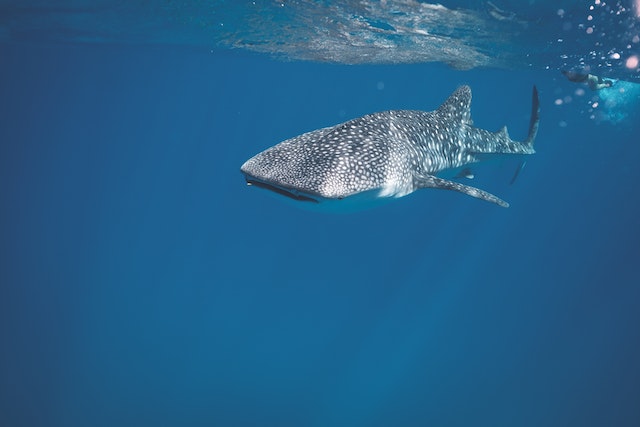
Is a whale shark a whale or a shark? A whale shark is a shark and not a whale.
The difference between whales and sharks is that whales are mammals and sharks are fish. What are the differences between mammals and fish? Mammals are “vertebrate animals in which the young are nourished with milk from special mammary glands of the mother”. Giving birth to live young is a characteristic of nearly all mammals (except for the duck billed platypus and the spiny anteater), but some reptiles, and fish give birth to live young. Many types of sharks lay eggs, but some do give birth to live young. Mammals are also warm-blooded and are able to generate their own heat.
Whales are mammals because they have a backbone and because they nurture their young with milk. It seems odd to imagine because they live in the oceans and you wouldn’t think of whales as producing milk, but they do. The female whale has inverted nipples so that milk doesn’t leak into the sea and when the baby whale wants to feed, it nudges against the mother and the nipples stick out. Whales don’t have lips, so the babies can’t suck the milk out. Instead, the baby forms a seal and the mother forces the milk out using muscles. The milk has a very high fat content because baby whales need to put on a lot of fat very quickly to insulate them in the cold ocean. Whales are also warm-blooded. They have thick layers of insulating blubber to keep the heat in and they are able to regulate their body temperature making heat from the food that they eat.
A fish is defined as “a cold-blooded animal that lives in water, breathes with gills, and usually has fins or scales”. Sharks are fish because they are cold-blooded. Their body temperature is the same as the water temperature they live in. That is one of the reasons why Greenland Sharks move so slowly and live for so long. Sharks have gills, which take oxygen out of the water as it passes through them. Some sharks have to keep moving to ensure a constant flow of water across the gills, but some sharks have a method of pumping the water across the gills. And, sharks have fins and scales. They have very small, flat, V-shaped scales that keep them streamlined and let them move so quickly through the water.
So, is a whale shark a whale or a shark? They are sharks because they have all of the characteristics of a shark and none of the characteristics of a mammal. They are called whale sharks because of their size. The largest whale shark ever found was 18.8 meters long and the females of the species are larger than the males. The males can grow up to about 9 meters but the females regularly grow up to 14 meters long. They are the largest known species of fish and they are very slow-moving filter feeders. They have very large mouths and they eat plankton, small fish, or clouds of eggs laid by mass spawning fish. They are called filter feeders because they swim along with their mouths open and filter the food out of the water when it comes into their mouths. They have something called filter pads which look like a sieve and trap the food while letting the water flow through and out of their gills. The food on the filter pads is then directed to the throat and down into the stomach. They have about twenty filter pads and they can process up to 6000 liters of water an hour. These filter pads can get fouled up with food and whale sharks will actually cough to clear them.
Whale sharks do have teeth but they are not dangerous to humans because they don’t bite. There has never been a recorded death of a human by a whale shark. We are far more dangerous to them than they are to us. They are killed by boats or hunted, but they are also at a huge risk from microplastics. Because of the way that they eat, they scoop up a large quantity of plastic whenever they eat. This plastic can foul up their filter pads and they ingest a lot of it. The plastic in the oceans is not only affecting the sea life, it is also in our blood. And that is what I learned today.
Photo by Lachlan Ross: https://www.pexels.com/photo/dangerous-shark-swimming-underwater-of-sea-5967796/
Sources
https://kids.nationalgeographic.com/animals/fish/facts/whale-sharks
https://www.wwf.org.uk/learn/fascinating-facts/whale-sharks
https://en.wikipedia.org/wiki/Whale_shark
https://saveourseas.com/worldofsharks/is-a-shark-a-fish-or-a-mammal
https://www.britannica.com/animal/mammal
https://www.aquariumofpacific.org/blogs/comments/how_do_whales_nurse_lets_find_out
https://www.merriam-webster.com/dictionary/fish
